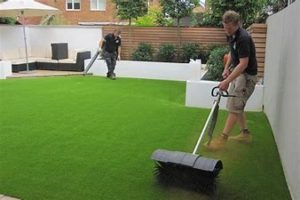When considering installing artificial grass, make sure you know exactly what is involved. You’ll need to determine what kind of grass is best for your space, and which types of infill to use. Infill comes in many forms, including silica sand, flex sand, and acrylic-coated temperature-reducing sand. Different types have different price tags, so it’s important to understand which one will best fit your needs. Check out this page Artificial Grass Pros of Orlando – Turf Installation Near Me
 First, make sure that you have a flat surface that’s level and free of rocks or debris. Next, prepare a base layer that’s deep and level. For flat surfaces, use landscaping rakes or tamping machines to smooth out the area. Lastly, fill the base with water and compact it with a lawn roller. The final step is to install the artificial grass. Ensure that you’ve cleared the area well and are prepared for the installation process.
First, make sure that you have a flat surface that’s level and free of rocks or debris. Next, prepare a base layer that’s deep and level. For flat surfaces, use landscaping rakes or tamping machines to smooth out the area. Lastly, fill the base with water and compact it with a lawn roller. The final step is to install the artificial grass. Ensure that you’ve cleared the area well and are prepared for the installation process.
Once the base material is chosen, the artificial grass is secured in place using nails. In mild climates, type 1 stone, gravel, crushed rock, and decomposed granite are good choices. A minimum of three to four inches of base material is recommended to promote drainage and prevent sagging. When selecting a sub-base material, keep in mind that you can’t simply use coarse or sharp sand. You’ll need something firm, but that absorbs surface water quickly.
If you’re not comfortable installing artificial grass yourself, you can hire a professional. It takes about one to three days to complete a typical artificial grass installation. In addition to being environmentally friendly, artificial grass requires less water than natural grass. This is especially important for cities and other areas where water conservation is a top priority. It’s also easier to maintain, which saves money. You’ll find the tools needed to install artificial grass in a few hours.
Choosing the right type of synthetic grass depends on its primary use. It could be for a home lawn, pet yard, or putting green. Medium-height synthetic grass will be made from polyethylene and will have multi-hued colors. The color will resemble a healthy natural lawn, with several shades of green and brown tones. If you’re not sure, ask a professional to help you select the best type of grass for your space.
Labor costs can vary widely between companies. Avoid any company with labor costs that are significantly lower than $12 per square foot, as it’s likely they’ll cut corners during installation. Generally, a standard 500 square foot artificial lawn installation costs anywhere from $5,000 to $8,000, and the average cost of installation in the United States is $5,860. Make sure you factor in other costs, such as the cost of materials and labor, to help you make an informed decision.
The first step in artificial grass installation is to choose a road base for your area. Typically, class 11 road base is a combination of crushed rocks and crushed stone. The crushed rocks should be below 3/4 of an inch in depth. It costs $0.40 per square foot and is a critical first step to installing synthetic grass. You’ll also need a weed barrier fabric to keep natural weeds out. Weed barrier fabric costs between $85 and $290 per thousand square feet.
